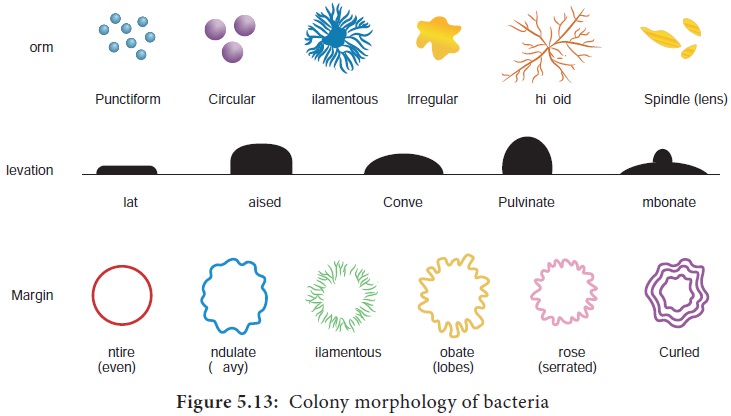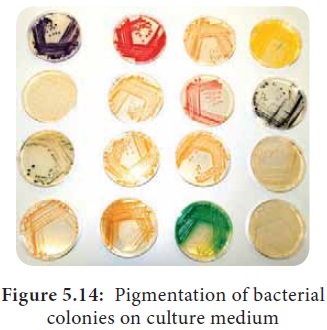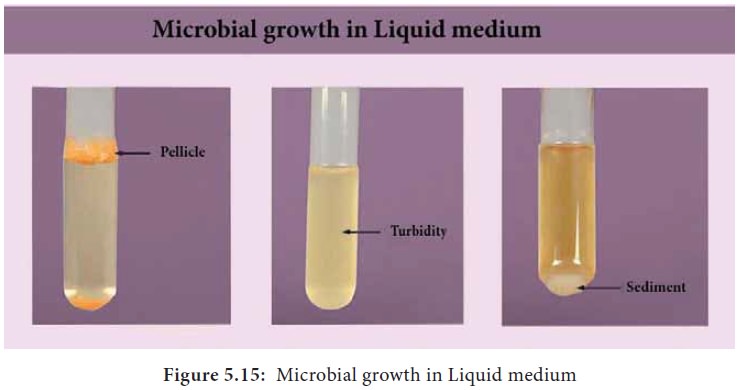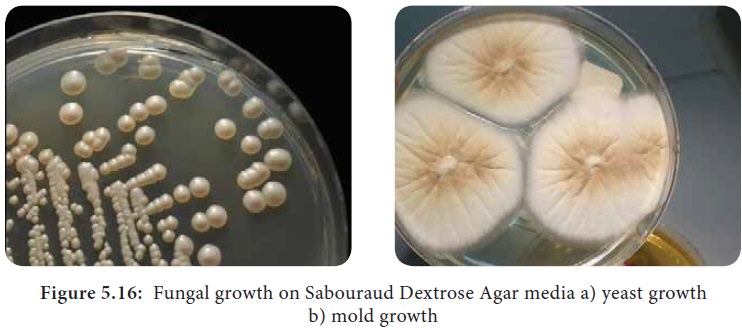Chapter: 11th Microbiology : Chapter 5 : Cultivation of Microorganisms
Growth and Colony Characteristics of Bacteria and Fungi
Growth and Colony Characteristics
of Bacteria and Fungi
In the previous section we have learned the various types of
media and specific purpose of each medium. Morphology is the basic criteria for
the isolation, identification and classification of microorganisms. Colony
characteristics are the basic tool in the field of taxonomy.
Bacteria grow in both solid and liquid medium, but
identification will be easy on the solid medium. In solid medium bacteria form
colonies. In liquid medium growth of bacteria are generally not distinctive
because there is uniform turbidity or sediment at the bottom or pellicle is
formed on the surface.
Some basic attributes such as shape, size, colour, pigmentation, texture, elevation and margin of the bacterial colony in the growth medium are explained below.
Colony Morphology of Bacteria on Solid Media
Shape: The shape of colony
may be circular, irregular, filamentous, rhizoid.
Elevation: It is the side view of
the colony. It may be flat,
raised, umbonate (having a knobby protuberance) crateriform, convex pulvinate
(cushion shaped)
Margin: The margin of the
bacterial colony may be entire (smooth)
irregular, undulate (ovary), lobate, curled, filiform. The irregular shape of
the colony give irregular margin (Figure 5.13).

Colony Size: The diameter of the
colony is measured in millimeter. It is described in relative terms
such as pinpoint, small, medium and large.
Appearance of colony on the
surface: The bacterial colonies are frequently shiny/ smooth in appearance.
Colonies may be veined, rough, dull, wrinkled, or glistening.
Texture of the colony: Texture means consistency of the bacterial growth. It may be dry, moist,
mucoid, brittle (dry breaks apart), viscid (sticks to loop, hard to get off),
viscous, or butyrous (buttery).
Opacity of the bacterial Colony: Colonies may exhibit different optical density. It may be transparent
(clear), opaque (not clear), translucent (almost clear), or iridescent
(changing colour in reflected light).
Colony Odour: Some bacteria produce
a characteristic smell, which sometimes helps in identifying the
bacteria. Actinomycetes produce an earthy odour which is quite often
experienced after rain. Many fungi produce fruity smell while Escherichia coli produce a faecal odour.
Colony Colour: Many bacteria develop colonies which are pigmented.(Table 5.3) Some bacteria produce
and retain water insoluble pigments and the colonies appear coloured by taking
the pigment intracellularly (Figure 5.14). But some bacteria produce water
soluble pigment which diffuse into the surrounding agar. Example: Pyocyanin pigment
of Pseudomonas aeruginosa is a water
soluble pigment and give blue colour
to the medium.


Nature of bacterial growth in liquid medium
·
If the entire broth appears milky and cloudy it is called
turbid.
·
If deposit of cells are present at the bottom of the tube, the
term sediment is used.
·
If the bacterial growth forms a continous or interrupted sheet
over the broth it is called pellicle (Figure 5.15).

Growth and Colony Characteristics of Fungi
Fungi are eukaryotic organisms. They exist in both
unicellular-yeast like form and in filamentous multicellular hyphae or mold
form and some are dimorphic. Generally
Sabourad Dextrose
Agar (SDA) plates and Potato Agar plates are used for general cultivation of
fungi. The acidic nature of SDA agar reduce the growth of bacteria.
The characters to be noticed in colony of fungi are colour of
the surface and reverse of the colony, texture of the surface (powdery,
granular, ecolly, cottony, velvety or glabrous), the topography (elevation,
folding, margin) and the rate of growth.
Growth and colony characteristics of yeast Candida
Yeasts are grown on Sabourad Dextrose Agar aerobically. Yeasts
grow as typical pasty colonies and give out yeasty odour. The colony morphology
varies with different yeasts. Yeasts colonies generally have smooth texture and
are larger than bacterial colonies on SDA medium (Figure 5.16a).

Growth and Colony characteristics of mold Mucor
The genus Mucor is
typically coloured white to brown or grey and is fast growing. Older colonies
become grey to brown due to the development of spores. (Figure 5.16b).
Related Topics